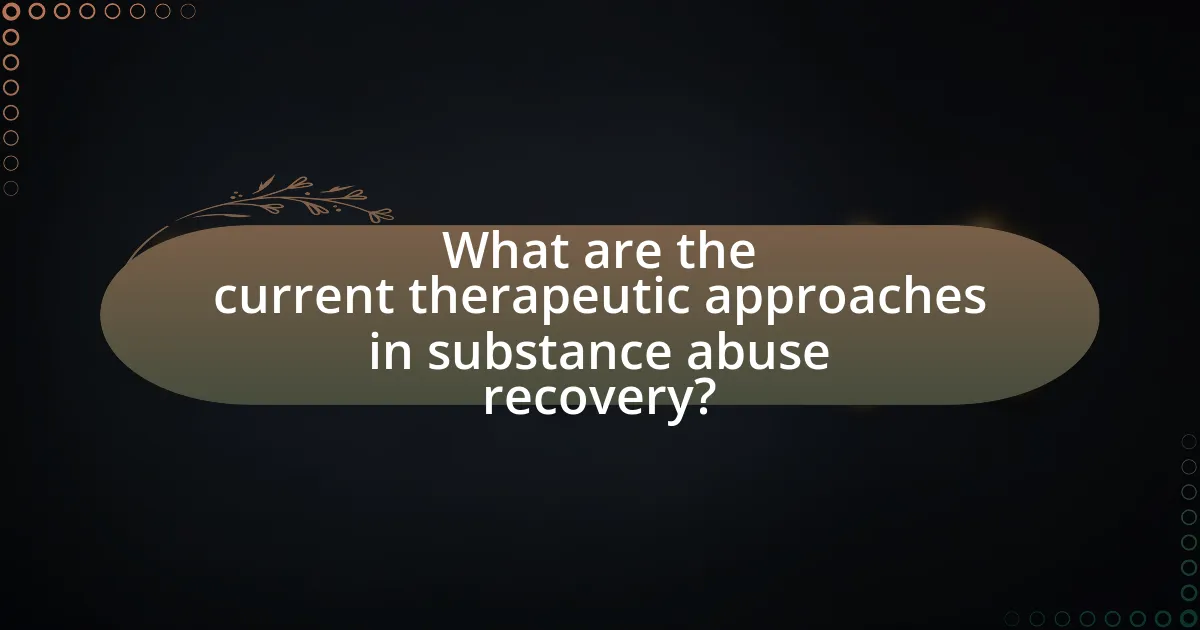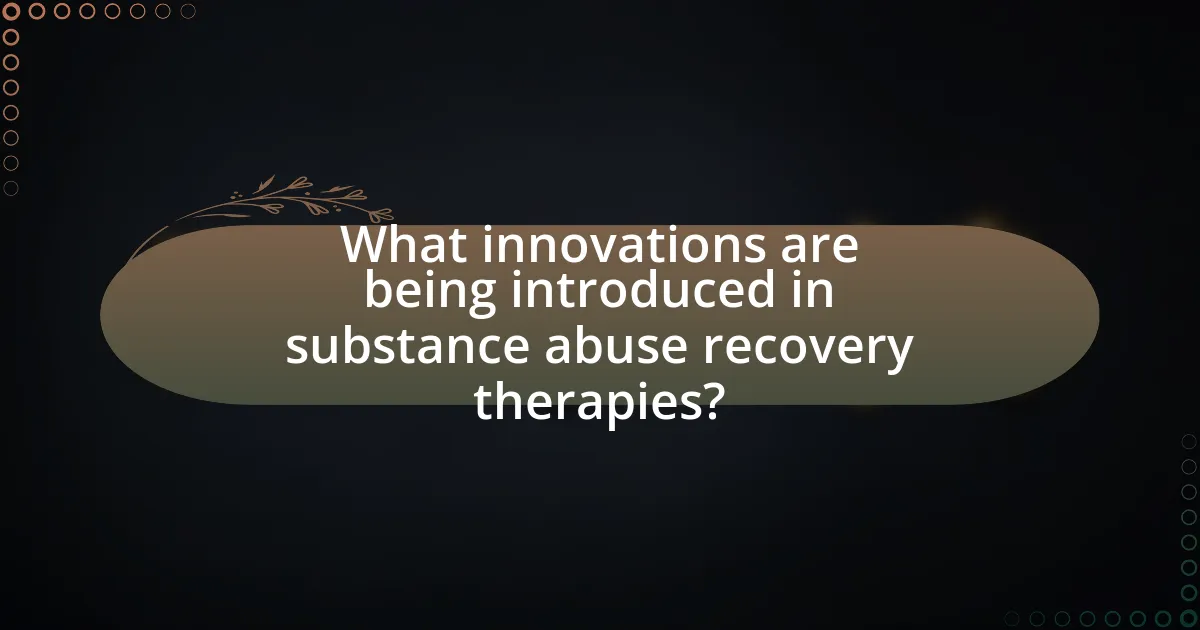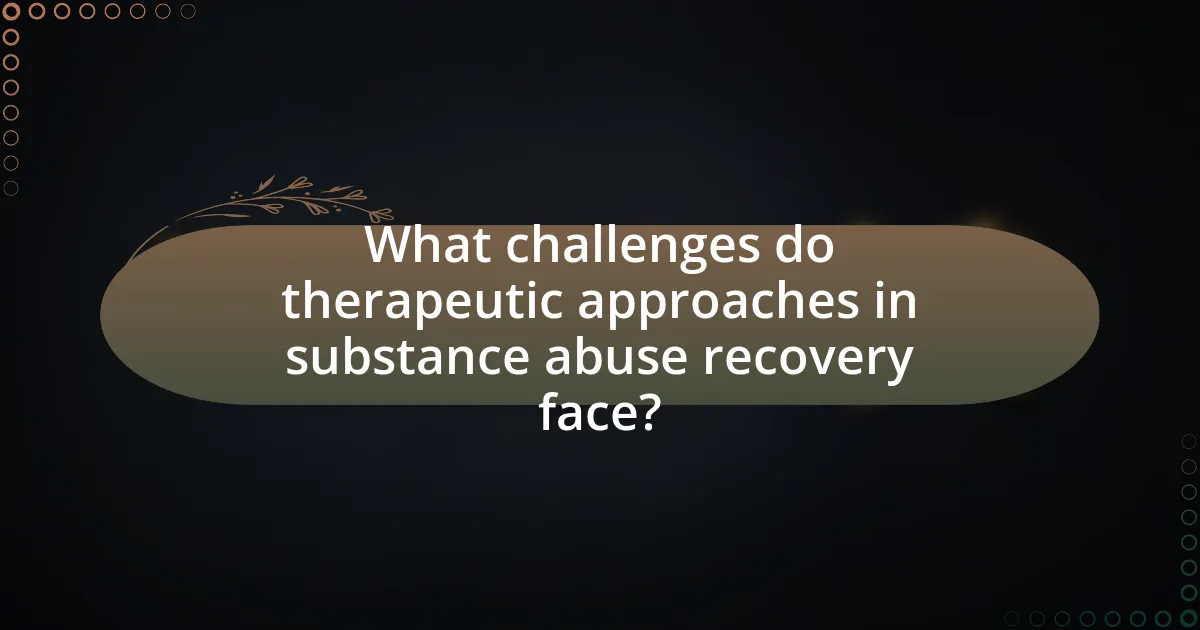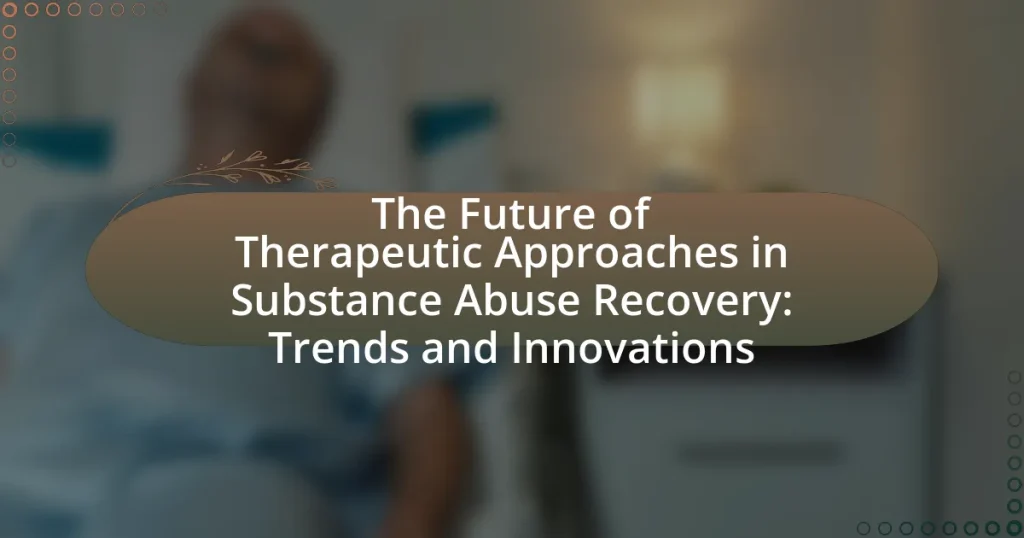The article focuses on the future of therapeutic approaches in substance abuse recovery, highlighting current methods such as cognitive-behavioral therapy, motivational interviewing, and medication-assisted treatment. It compares traditional recovery methods with modern innovations, emphasizing the role of technology and personalized medicine in enhancing treatment efficacy. The discussion includes the effectiveness of behavioral therapies, pharmacological treatments, and emerging trends like telehealth and holistic care. Additionally, it addresses challenges such as stigma, access to care, and the importance of community resources in supporting recovery efforts. Overall, the article provides a comprehensive overview of the evolving landscape of substance abuse recovery therapies.

What are the current therapeutic approaches in substance abuse recovery?
Current therapeutic approaches in substance abuse recovery include cognitive-behavioral therapy (CBT), motivational interviewing, medication-assisted treatment (MAT), and contingency management. CBT focuses on changing negative thought patterns and behaviors associated with substance use, while motivational interviewing enhances an individual’s motivation to change. MAT combines behavioral therapy with medications like methadone or buprenorphine to treat opioid addiction, and contingency management provides tangible rewards for positive behaviors such as abstinence. These approaches are supported by research indicating their effectiveness in reducing substance use and improving recovery outcomes. For instance, a study published in the Journal of Substance Abuse Treatment found that individuals receiving MAT had significantly lower rates of opioid use compared to those receiving only counseling.
How do traditional methods compare to modern innovations?
Traditional methods in substance abuse recovery, such as 12-step programs and counseling, often emphasize community support and personal accountability, while modern innovations leverage technology and evidence-based practices to enhance treatment efficacy. Traditional approaches have a long history of success, with studies indicating that 12-step programs can lead to significant long-term recovery rates, as evidenced by a 2006 study published in the Journal of Substance Abuse Treatment, which found that participants in these programs had a higher likelihood of abstinence after one year compared to those who did not participate. In contrast, modern innovations, including teletherapy and digital health applications, provide greater accessibility and personalized treatment options, as highlighted by a 2020 report from the National Institute on Drug Abuse, which noted that telehealth services increased engagement and retention in treatment during the COVID-19 pandemic. Thus, while traditional methods focus on interpersonal connections and structured support, modern innovations aim to enhance accessibility and tailor interventions to individual needs, reflecting a shift towards a more integrated approach in substance abuse recovery.
What role do behavioral therapies play in recovery?
Behavioral therapies play a crucial role in recovery from substance abuse by addressing the underlying psychological factors that contribute to addiction. These therapies, such as Cognitive Behavioral Therapy (CBT) and Dialectical Behavior Therapy (DBT), help individuals identify and change negative thought patterns and behaviors associated with substance use. Research indicates that CBT can reduce substance use and improve coping strategies, with studies showing a 30-50% reduction in relapse rates among participants. Additionally, behavioral therapies enhance motivation for change and improve overall mental health, which are essential components for sustained recovery.
How effective are pharmacological treatments in substance abuse recovery?
Pharmacological treatments are highly effective in substance abuse recovery, significantly improving outcomes for individuals struggling with addiction. Research indicates that medications such as methadone, buprenorphine, and naltrexone can reduce cravings and withdrawal symptoms, leading to higher retention rates in treatment programs. For instance, a study published in the Journal of the American Medical Association found that patients receiving medication-assisted treatment for opioid use disorder had a 50% lower risk of overdose compared to those not receiving such treatments. Additionally, pharmacological interventions can be combined with behavioral therapies to enhance overall recovery success, demonstrating their critical role in comprehensive treatment strategies.
What emerging trends are shaping therapeutic approaches?
Emerging trends shaping therapeutic approaches in substance abuse recovery include the integration of technology, personalized treatment plans, and a focus on holistic care. Technology, such as teletherapy and mobile health applications, enhances accessibility and engagement, allowing patients to receive support remotely. Personalized treatment plans, informed by genetic and psychological assessments, enable tailored interventions that address individual needs, improving outcomes. Additionally, holistic care approaches that incorporate mental, emotional, and physical health are gaining traction, recognizing the interconnectedness of these aspects in recovery. These trends are supported by research indicating that personalized and holistic methods lead to higher success rates in treatment adherence and recovery.
How is technology influencing substance abuse recovery therapies?
Technology is significantly influencing substance abuse recovery therapies by enhancing accessibility, personalization, and engagement in treatment. Digital platforms, such as teletherapy and mobile applications, allow individuals to access support and resources remotely, which is crucial for those in rural or underserved areas. For instance, a study published in the Journal of Substance Abuse Treatment found that telehealth services increased treatment retention rates by 30% compared to traditional in-person therapy. Additionally, technology enables personalized treatment plans through data analytics, allowing therapists to tailor interventions based on individual progress and needs. Furthermore, gamification and virtual reality are being integrated into therapies to improve engagement and motivation, making recovery more interactive and appealing. These advancements demonstrate that technology is reshaping the landscape of substance abuse recovery, making it more effective and accessible.
What is the impact of holistic approaches on recovery outcomes?
Holistic approaches significantly enhance recovery outcomes by addressing the physical, emotional, and spiritual needs of individuals. Research indicates that integrating practices such as mindfulness, yoga, and nutrition into traditional treatment methods can lead to improved mental health, reduced relapse rates, and greater overall well-being. For instance, a study published in the Journal of Substance Abuse Treatment found that participants who engaged in holistic therapies alongside conventional treatment reported higher satisfaction and lower levels of anxiety and depression. This evidence supports the effectiveness of holistic approaches in fostering a more comprehensive recovery process.

What innovations are being introduced in substance abuse recovery therapies?
Innovations in substance abuse recovery therapies include the integration of technology, such as telehealth services, virtual reality (VR) therapy, and mobile applications for monitoring and support. Telehealth has expanded access to treatment, allowing individuals to receive therapy remotely, which has been particularly beneficial during the COVID-19 pandemic, as evidenced by a 2021 study published in the Journal of Substance Abuse Treatment that reported a 50% increase in telehealth usage among substance abuse patients. Virtual reality therapy offers immersive experiences that can help individuals confront triggers in a controlled environment, enhancing coping skills. Additionally, mobile applications provide real-time support and resources, facilitating ongoing engagement in recovery. These innovations reflect a shift towards more accessible, personalized, and technology-driven approaches in substance abuse recovery.
How are digital health tools transforming recovery processes?
Digital health tools are transforming recovery processes by enhancing accessibility, personalization, and engagement in substance abuse treatment. These tools, such as mobile applications and telehealth platforms, provide users with immediate access to resources, support networks, and therapeutic interventions, which can significantly improve adherence to recovery plans. For instance, a study published in the Journal of Substance Abuse Treatment found that individuals using mobile health applications reported a 30% increase in engagement with their recovery programs compared to traditional methods. Additionally, digital tools enable personalized treatment plans through data analytics, allowing for real-time adjustments based on user feedback and progress. This adaptability is crucial, as it addresses the unique needs of each individual, thereby increasing the likelihood of successful recovery outcomes.
What types of apps are available for substance abuse recovery support?
Various types of apps are available for substance abuse recovery support, including self-help apps, community support platforms, and professional therapy applications. Self-help apps often provide tools for tracking sobriety, managing cravings, and offering motivational content. Community support platforms connect users with peer support groups and forums for shared experiences. Professional therapy applications facilitate remote counseling sessions and provide access to licensed therapists. Research indicates that mobile health interventions can significantly improve recovery outcomes, as evidenced by a study published in the Journal of Substance Abuse Treatment, which found that participants using such apps reported higher rates of abstinence and engagement in treatment.
How do telehealth services enhance accessibility to treatment?
Telehealth services enhance accessibility to treatment by allowing patients to receive care remotely, eliminating geographical barriers and reducing the need for travel. This mode of service delivery is particularly beneficial for individuals in rural or underserved areas, where healthcare facilities may be limited. According to a study published in the Journal of Substance Abuse Treatment, telehealth can increase treatment engagement by 50% among individuals with substance use disorders, demonstrating its effectiveness in reaching populations that might otherwise avoid traditional in-person visits. Additionally, telehealth services often provide flexible scheduling options, accommodating patients’ needs and improving adherence to treatment plans.
What role does personalized medicine play in recovery?
Personalized medicine plays a crucial role in recovery by tailoring treatment plans to the individual characteristics of patients, including their genetic makeup, lifestyle, and specific substance use patterns. This approach enhances the effectiveness of interventions, as it allows healthcare providers to select therapies that are more likely to succeed based on the unique biological and psychological profiles of patients. For instance, studies have shown that genetic testing can identify individuals who may respond better to certain medications, thereby improving treatment outcomes and reducing the risk of relapse. Additionally, personalized medicine can help in monitoring patient progress and adjusting treatment strategies in real-time, which is essential for effective recovery in substance abuse cases.
How can genetic testing inform treatment plans?
Genetic testing can inform treatment plans by identifying specific genetic variations that influence an individual’s response to medications and therapies. For instance, pharmacogenomic testing can reveal how a person metabolizes certain drugs, allowing healthcare providers to tailor medication choices and dosages to enhance efficacy and minimize adverse effects. Research has shown that individuals with specific genetic markers may respond better to certain treatments; for example, a study published in the Journal of Substance Abuse Treatment found that patients with particular genetic profiles had improved outcomes when prescribed medications aligned with their genetic makeup. This personalized approach can lead to more effective and safer treatment strategies in substance abuse recovery.
What are the benefits of tailored therapeutic interventions?
Tailored therapeutic interventions provide personalized treatment plans that enhance the effectiveness of substance abuse recovery. These interventions address the unique needs, preferences, and circumstances of individuals, leading to improved engagement and adherence to treatment. Research indicates that personalized approaches can significantly increase the likelihood of positive outcomes, with studies showing that individuals receiving tailored interventions are more likely to achieve sustained recovery compared to those receiving standard treatments. For instance, a meta-analysis published in the Journal of Substance Abuse Treatment found that personalized interventions resulted in a 30% higher success rate in recovery outcomes.

What challenges do therapeutic approaches in substance abuse recovery face?
Therapeutic approaches in substance abuse recovery face several significant challenges, including high relapse rates, varying individual responses to treatment, and limited access to care. High relapse rates, which can exceed 60% within the first year of recovery, indicate that many individuals struggle to maintain sobriety despite therapeutic interventions. Additionally, individual responses to treatment can vary widely due to factors such as co-occurring mental health disorders, social support systems, and personal motivation, complicating the effectiveness of standardized therapeutic models. Limited access to care, particularly in underserved communities, further exacerbates these challenges, as many individuals may not receive timely or adequate treatment options. These factors collectively hinder the overall success of therapeutic approaches in substance abuse recovery.
How do stigma and societal perceptions affect recovery efforts?
Stigma and societal perceptions significantly hinder recovery efforts by creating barriers to treatment access and fostering feelings of shame among individuals seeking help. Research indicates that individuals with substance use disorders often face discrimination, which can discourage them from pursuing necessary treatment. For example, a study published in the Journal of Substance Abuse Treatment found that 60% of participants reported feeling stigmatized, leading to decreased likelihood of seeking help. Additionally, societal perceptions that frame addiction as a moral failing rather than a medical condition contribute to isolation and reluctance to engage in recovery programs. This negative environment can exacerbate mental health issues and prolong substance use, ultimately impeding recovery outcomes.
What strategies can be employed to combat stigma in treatment settings?
To combat stigma in treatment settings, implementing education and training programs for healthcare providers is essential. These programs can enhance understanding of substance use disorders, thereby reducing misconceptions and biases. Research indicates that stigma can significantly hinder treatment engagement and recovery outcomes; for instance, a study published in the Journal of Substance Abuse Treatment found that stigma negatively impacts individuals’ willingness to seek help. Additionally, fostering a supportive environment through peer support programs can empower individuals in recovery, promoting acceptance and reducing feelings of isolation.
How does access to care impact recovery success rates?
Access to care significantly impacts recovery success rates by ensuring individuals receive timely and appropriate treatment for substance abuse. Studies indicate that individuals with better access to healthcare services, including mental health support and addiction treatment, experience higher rates of recovery. For instance, a report from the Substance Abuse and Mental Health Services Administration (SAMHSA) shows that individuals who engage in treatment within 30 days of seeking help have a 50% higher chance of achieving long-term sobriety compared to those who delay treatment. This correlation underscores the importance of accessible care in facilitating effective recovery outcomes.
What are the barriers to implementing innovative therapies?
The barriers to implementing innovative therapies in substance abuse recovery include regulatory hurdles, funding limitations, and lack of trained professionals. Regulatory hurdles arise from stringent approval processes that can delay the introduction of new therapies, as seen with the lengthy FDA approval timelines for novel treatments. Funding limitations often restrict research and development, making it difficult to bring innovative therapies to market; for instance, a study by the National Institute on Drug Abuse highlights that only a fraction of proposed therapies receive adequate funding. Additionally, the lack of trained professionals to administer and support these therapies can hinder their effectiveness, as evidenced by workforce shortages in addiction treatment services.
How can funding and policy changes support new therapeutic approaches?
Funding and policy changes can significantly support new therapeutic approaches by providing the necessary financial resources and regulatory frameworks that facilitate research, development, and implementation. Increased funding allows for the exploration of innovative treatment modalities, such as evidence-based therapies and holistic approaches, which have shown promise in substance abuse recovery. For instance, the National Institute on Drug Abuse reported that targeted funding for research into behavioral therapies has led to improved outcomes for individuals with substance use disorders. Additionally, policy changes that prioritize mental health and substance abuse treatment can create an environment conducive to the adoption of new therapies, as seen in states that have expanded Medicaid coverage for addiction treatment services. These changes not only enhance access to care but also encourage the integration of new therapeutic methods into existing healthcare systems, ultimately leading to better recovery outcomes.
What role do healthcare providers play in overcoming these barriers?
Healthcare providers play a crucial role in overcoming barriers to substance abuse recovery by offering comprehensive support, education, and tailored treatment plans. They assess individual needs, provide evidence-based interventions, and facilitate access to resources, which helps to address issues such as stigma, lack of awareness, and limited access to care. For instance, studies show that healthcare providers who engage in motivational interviewing can significantly improve patient outcomes by enhancing motivation and readiness to change. Additionally, by collaborating with community organizations, healthcare providers can bridge gaps in services, ensuring that patients receive holistic care that addresses both physical and psychological aspects of recovery.
What best practices can enhance the effectiveness of therapeutic approaches in substance abuse recovery?
Best practices that enhance the effectiveness of therapeutic approaches in substance abuse recovery include the integration of evidence-based treatments, personalized care plans, and ongoing support systems. Evidence-based treatments, such as Cognitive Behavioral Therapy (CBT) and Motivational Interviewing, have been shown to significantly improve recovery outcomes by addressing the psychological aspects of addiction. Personalized care plans, tailored to individual needs and circumstances, increase engagement and adherence to treatment, as supported by research from the Substance Abuse and Mental Health Services Administration (SAMHSA). Additionally, ongoing support systems, including peer support groups and aftercare programs, provide essential social reinforcement and accountability, which are critical for long-term recovery success.
How can continuous education for providers improve treatment outcomes?
Continuous education for providers enhances treatment outcomes by ensuring that healthcare professionals remain updated on the latest evidence-based practices and therapeutic techniques. This ongoing training allows providers to apply new knowledge and skills in their treatment approaches, leading to more effective interventions. Research indicates that providers who engage in continuous education demonstrate improved patient engagement and adherence to treatment protocols, which are critical factors in successful recovery outcomes. For instance, a study published in the Journal of Substance Abuse Treatment found that providers who participated in regular training sessions reported a 30% increase in treatment efficacy compared to those who did not engage in continuous education.
What community resources can support individuals in recovery?
Community resources that can support individuals in recovery include support groups, counseling services, and rehabilitation centers. Support groups, such as Alcoholics Anonymous and Narcotics Anonymous, provide peer support and shared experiences, which are crucial for recovery. Counseling services offer professional guidance and therapy, addressing underlying issues related to substance abuse. Rehabilitation centers provide structured programs that include medical care, therapy, and life skills training, facilitating a comprehensive recovery process. According to the Substance Abuse and Mental Health Services Administration, access to these resources significantly improves recovery outcomes, highlighting their importance in the recovery journey.
